“Fine medieval, Tudor and Georgian doorways once abounded in Norwich, but they are rapidly disappearing.“(Kent & Stephenson, 1948).
In 1948, Kent and Stephenson published a book of photographs of ancient buildings celebrating our ‘Norwich Inheritance’ [1]. Close to the Second World War it was surprising that they didn’t dwell on losses to enemy bombing. Instead, they wanted to record what remained, to show how easy and elegant Norwich once looked and perhaps might look again. But they seemed to have had little confidence in post-war renewal, suspecting that there was a, “danger of throwing away this heritage … for a commercial conglomeration of humdrum mediocrity”. You be the judge.
Kent and Stephenson worried that little would remain in 50 years time. Almost 70 years later, I thought I would try to find the 20 doors illustrated in their section on ‘The Doorways of Norwich’.
1. The Old Bridewell Entrance, St Andrew’s Hill. This four-plank door, with joints covered by fillets, is a replacement for the 5/6-plank door illustrated by Kent and Stephenson [1]. The head of the Tudor door with carved spandrels survives; the Gothic grille is hanging on but needs repair. George Plunkett [2] said it was the oldest of its kind in the city, dating it to ca. 1490 (early Tudor). The history of the Gothic arch is of a gradual flattening, from the steeply pointed lancet windows of the Early English style to the Perpendicular/Tudor phase where the four-centred arch produced a flatter profile.

The Old Bridewell Entrance, St Andrew’s Hill. The Tudor arch is still noticeably pointed in this early doorway but gets flatter throughout this period.
No 2. Bacon’s House 31 Colegate (now numbered 35). This house was built for Henry Bacon, a wealthy worsted merchant who was mayor and sheriff in the mid 1500s. The several rectangles of newer wood set into the Tudor door replaced the letterboxes and other door furniture described by Kent and Stephenson as ‘a disfigurement’. There is a separate ‘wicket’ door within this door with its own spandrels.
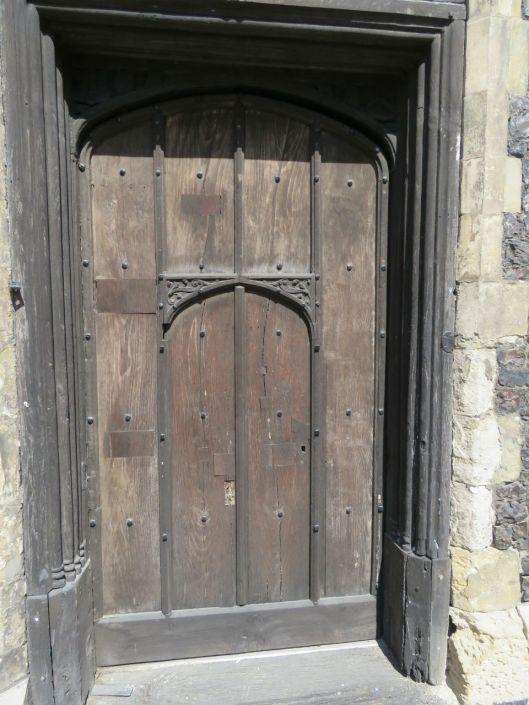
Henry Bacon’s House, Colegate.
No 3. Bayfield’s Court, Stump Cross. This Tudor doorway is no longer in existence, a possible victim of the 1960s inner link road and flyover that aimed (and missed by a country mile) to have minimal impact on medieval Magdalen Street. Thankfully, in 1935 George Plunkett recorded this Tudor doorway with its carved spandrels bearing the date and owner’s name (not Bayfield who was a C19th owner).
![Magdalen St Bayfield's Yard Tudor archway [0515] 1935-05-05.jpg](https://colonelunthanksnorwich.com/wp-content/uploads/2016/05/magdalen-st-bayfields-yard-tudor-archway-0515-1935-05-05.jpg?w=529)
Bayfield Court (demolished) [George Plunkett archive, 1935]

Shaw’s or (Shave’s Yard), Colegate.
No 5. 29 Magdalen Street. Twenty nine Magdalen Street was the house of Thomas Shipdham whose initials may be those in the right-hand spandrel. He was a rich mercer who became sheriff then, in 1631, the mayor. Although the date of 1612 in the left-hand spandrel places it outside the Tudor dynasty (1485-1603) this well-preserved doorway is clearly in the Tudor style.

29 Magdalen Street
No 6. Tudor doorway at Thorpe Lodge, Thorpe Road. This is no longer in existence. Instead, here is a medieval doorway that would not have been known by Kent and Stephenson for it was only uncovered about 2010 when repairing the render at the side of Roaches Yard off Elm Hill. The frame of the simple three-plank door has a Tudor four-centred arch with plain spandrels.
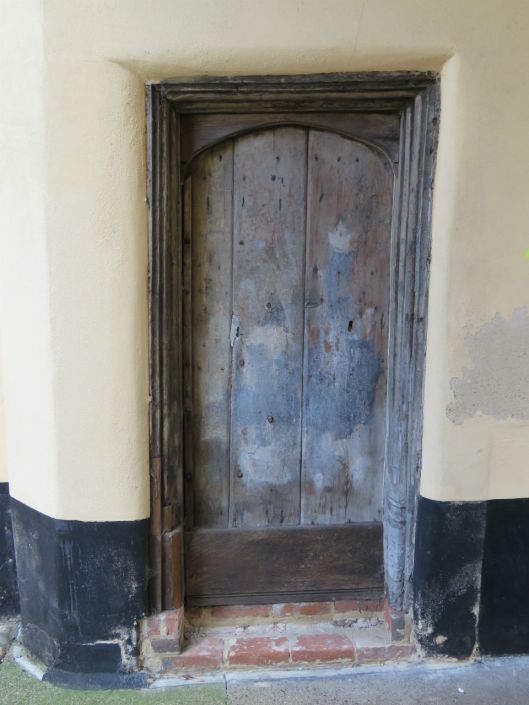
Roaches Court, to the side of No 36 Elm Hill.
No 7. Garsett House, St. Andrew’s Plain. The preceding Tudor style (1485-1603) had its roots in the Gothic but by the middle of the C18th Georgian architecture was heavily influenced by Neoclassicism. In this revival of interest in ancient Greek and Roman architecture, proportion and symmetry were central as was the ‘order’ or style of column used. Most of the following Norwich doorways were based on the Greek Doric order – the simplest order characterised by fluted (sometimes plain) columns topped with a plain capital. Another typical Doric feature was the cricket-wicket-like triglyph (III) that decorated the frieze or middle layer of the horizontal entablature. This can be seen at Garsett House, which was the first Georgian doorway described by Kent and Stephenson [1]. The medieval timber-framed house was modernised by adding this Classical portico. Above the six-panelled door is a rectangular transom light to illuminate the otherwise gloomy entrance hall. As the C18th progressed this style of light tended to be superseded by the semi-circular fanlight.
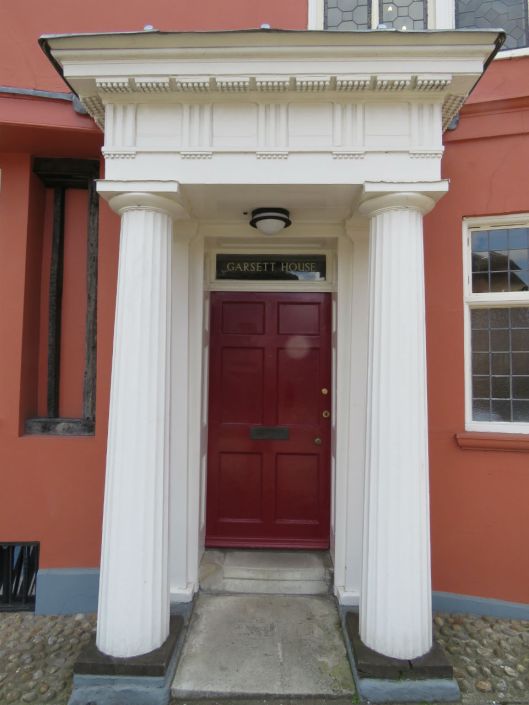
Garsett House
No 8. 17 Pottergate. Unfluted columns support a large and rusticated (projecting) keystone entablature. This stone doorway was said in 1948 [1] to be “in poor condition and suffering from a rash of bells”: the rash is gone.
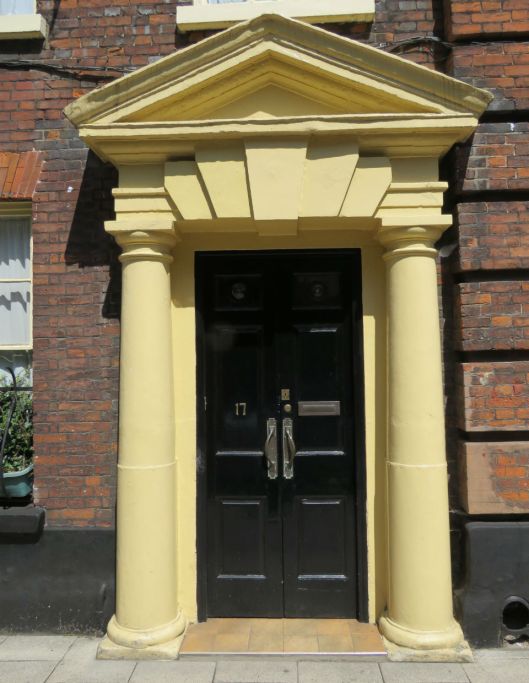
17 Pottergate
No 9. 46 St Giles. St Giles Street is Norwich’s finest Georgian street filled with the houses of the rich mercantile class. This Georgian doorway at No 46 is being renovated in 2016. The door furniture has not survived but the six-panelled door, fanlight and fluted columns appear to be as they were in 1948. Situated above the transom is a sun-ray fanlight. Fanlights added height to the doorway but the increase in overall size tended to be counteracted by their delicacy when finely cast in metal. Here, the horizontal entablature increases height further – as do the three doorsteps – but in adding width (and grandeur) the fluted columns restore proportion.

46 St Giles’ Street
No 10. 48 St Giles. The Reverend Robert Parr built the house in 1792 [1]. In May 2016, number 48 St Giles is shrouded in scaffolding but at least this wonderful portico survived the war and the post-war renewal. In 1948 Kent and Stephenson complained that the decorated Doric frieze was obscured by a badly placed YMCA sign [1]: today, despite the netting and scaffold poles, the entablature and fanlight are at least visible.

48 St Giles’ Street
No 11. Harvey’s House, 18 Colegate. Thomas Harvey (1710-1772), merchant, Mayor and Sheriff of Norwich, was born in this house. The doorway has fluted Ionic pillars capped by the angled scrolls or volutes that are characteristic of this order. George Plunkett [2] remembered coming across a note stating that a number of pillared doorways in Norwich were based on designs by Thomas Ivory – the city’s pre-eminent Georgian architect. Plunkett could find no supporting evidence but hoped that the best of the doorways were inspired by Ivory. Here he specifically named the next two doorways, 18 Colegate and 44 Magdalen Street. In these examples there is no fanlight. Instead, the solution for allowing light into a dark entrance hall was to glaze the top panels of the door itself, although this may have been done later. The door may be a replacement but considering the importance of this doorway the door furniture and signage are quite out of keeping. This probably explains the pained look on the keystone’s face above.
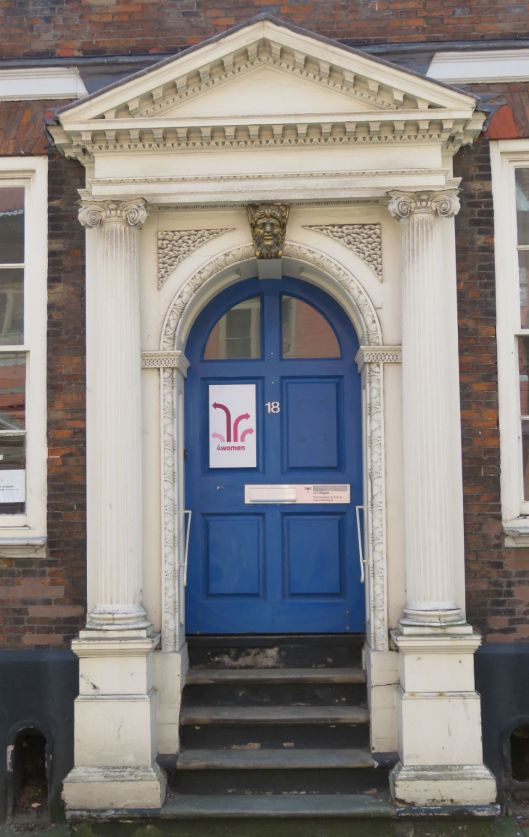
Harvey’s House 18 Colegate
No 12. 44 Magdalen Street. This is the other of George Plunkett’s two ‘best’ Norwich doorways.

44 Magdalen Street.
Magdalen Street, one of Norwich’s most celebrated medieval-to-Georgian streets largely survived the war but not the peace. The decision to bisect it with a flyover did not, as was anticipated, save the street but blighted it. Little thrives beneath the concrete and the surrounding post-war buildings are mostly derelict and an eyesore. However, look closely and it is still possible to pick out gems, like the Tudor and Georgian doorways illustrated here.
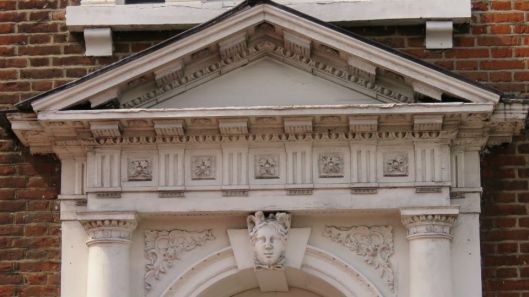
The frieze is classical Greek Doric with raised decoration between the triglyphs
No 13. All Saints’ Green. Ivory House was built in 1771-2 to a design by the well-known Norwich architect, Thomas Ivory. Kent and Stephenson [1] knew this building as ‘Artillery Barracks’ although I have seen it referred to as Militia Barracks. The horizontal joints of the columns are cut back to produce the rusticated banding. Pevsner and Wilson [4] liked “the good nine-vaned fanlight.’

Ivory House, All Saints’ Green
No 14. Gurney’s Court. This doorway survives more or less as illustrated by Kent and Stephenson although the fine Georgian lamp has been replaced [1]. The carved canopy seems to be Baroque rather than Classical and could be a remnant of a previous doorway. The plaque to the left celebrates the fact that two notable Norwich women – Elizabeth Fry and Harriet Martineau – were born in this house
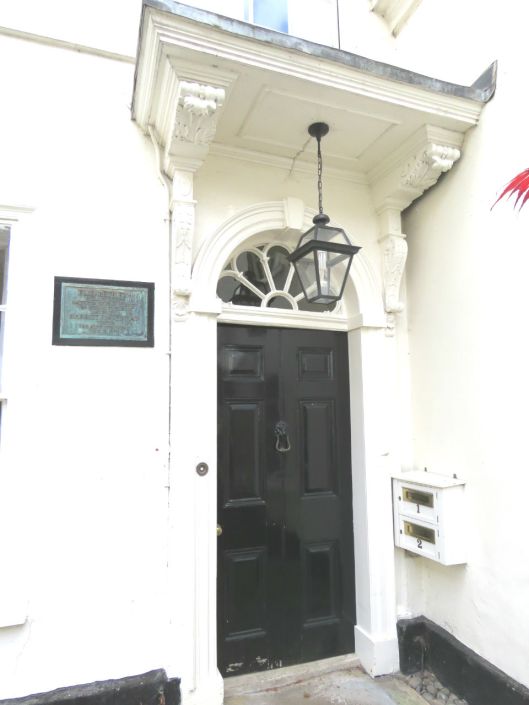
14 Gurney’s Court, Magdalen Street
No 15. St Catherine’s Court, All Saints’ Green. This Adam-style porch with its genteel swags was – even in 1948 – a plaster replica. Possibly, the original was damaged in the bombing raid that destroyed porticos in adjacent Surrey Street (see No19).

St Catherine’s Court
No 16. 79 King Street. Like Magdalen Street, King Street has suffered much since the war but, fortunately, this Georgian doorway remains as does the Venetian window above. The fanlight based on overlapping Gothic arches differs from the more usual variations on radiating sun rays. Contrast this doorway with No 9. (46 St Giles) whose height is exaggerated by a fanlight quite separate from the entablature above. Here at 79 King Street the triangular pediment is broken open at the base, allowing the fanlight to intrude into the entablature. In the second half of the C18th the broken pediment allowed doorways to be less tall and grandiose (e.g., where dictated by an entrance hall of limited height).

79 King Street
No 17 20 Colegate. Another fine townhouse belonging to the Harvey family, this Georgian doorway is unusual for Norwich, being made of stone. The temple-like doorway has a Doric entablature and unfluted columns. One suggestion is that the stone was recycled from the Duke of Norfolk’s Palace, just across the Wensum.
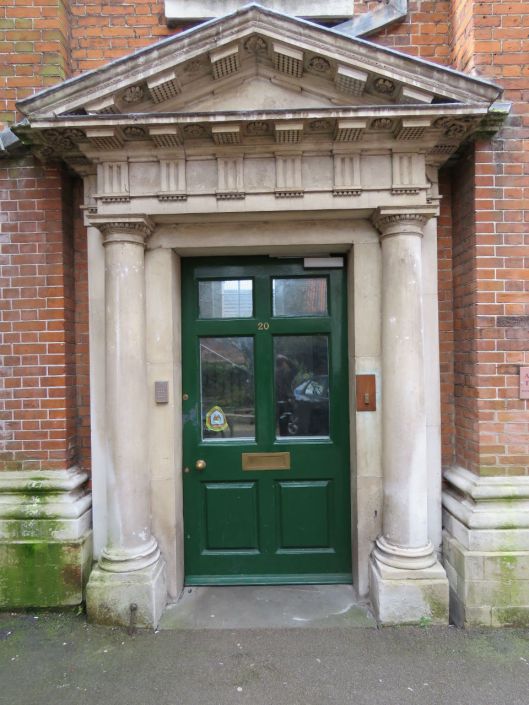
20 Colegate
No 18. Churchman House, 68 St Giles (now 71 Bethel Street). Churchman House, built in the early C18th for Alderman Thomas Churchman, has been described as ‘possibly the best Georgian provincial townhouse in England’[3]. The Churchmans were worsted weavers, underlining the point that when Norwich was the nation’s second city its wealth was largely derived from the wool trade. Although the wooden entablature and the triangular pediment are very similar to the stone version above, the overall effect here is less squat since the height of the doorway is stretched by inclusion of steps as well as fanlight. Inside, the rooms are proportionately tall. I was witness at a wedding here when it was Norfolk Register Office: now you have to get wed at the Castle.

Churchman House
No 19. 25 and 27 Surrey Street (demolished). This terrace is said to have been designed by Thomas Ivory. The projecting Doric entablature, supported by fluted pilasters and free-standing columns, provided the entrance to two houses, each having a fine door and rising-sun fanlight.
![Surrey St 25 to 27 Georgian portico [2187] 1938-03-21.jpg](https://colonelunthanksnorwich.com/wp-content/uploads/2016/05/surrey-st-25-to-27-georgian-portico-2187-1938-03-211.jpg?w=529)
25-27 Surrey St 1938. (c) George Plunkett
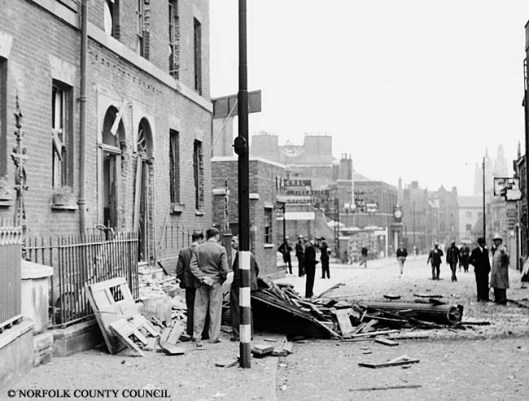
25 and 27 Surrey Street. Inspecting the bomb damage, 1940. Source: Picture Norfolk
In the photo below the war-damaged 25 and 27 Surrey Street are the furthest right of the three double porticos, but the other two survive today.
![Surrey St 25 to 35 [0588] 1935-05-19.jpg](https://colonelunthanksnorwich.com/wp-content/uploads/2016/05/surrey-st-25-to-35-0588-1935-05-192.jpg?w=529)
Surrey Street 25-35 (c) George Plunkett. Photographed in 1935. The two houses/porticos left and centre survived the bombing.
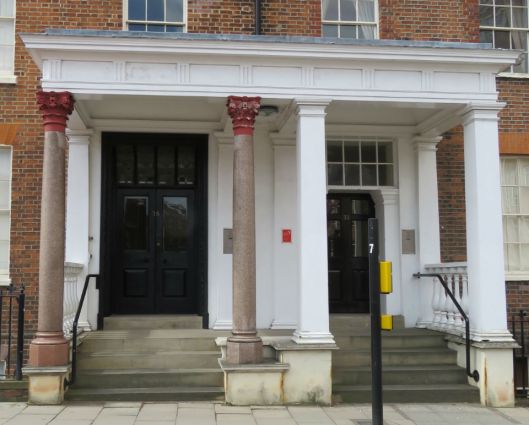
35 and 33 Surrey Street
No 20. 31 and 33 St Giles. These houses were originally built in the late C16th – early C17th and refaced in the late C18th [5]. The houses were not, therefore, built with Palladian proportions in mind so the late Georgian doorway would have been retrofitted to a less generous floor-plan. Spanning two doors with a common fanlight above the entablature required structural ingenuity since a semi-circular fanlight of that diameter would have been too tall for the hallways it was intended to illuminate. Instead, height was reduced by: using a narrow segment from a very large circle as a template for the fanlight (and confusing the radial spokes of the fanlight in the process); reducing the entablature to just the supporting architrave – no decorative frieze; and ensuring that the columns did not extend above the head of the door.
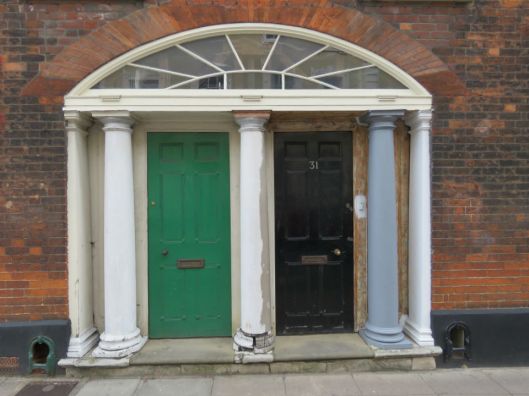
31 and 33 St Giles’ Street
The fact that 17 out of the 20 selected doorways [1] can still be seen today might seem to be cause for optimism. However, the selection was made from those still standing after the war. George Plunkett’s [2] much larger survey included doorways known to be present before the war and shows just how many fine buildings and doorways fell victim, not just to the war, but to C20th modernisation. As Joni Mitchell sang, “You don’t know what you’ve got till it’s gone.”
Next post: “Entrances and Exits (Doors II)”. Sign up for free email alerts.
Sources
- Kent, Arnold and Stephenson, Andrew (1948). Norwich Inheritance. Pub: Jarrold and Sons Ltd., Norwich
- Plunkett, George (1945). Old Norwich doorways. Norfolk Archaeology vol 28, pp39-70.
- Nierop-Reading, Vic. (2006). Visit to Churchman House. In, Norfolk Historic Buildings Group Newsletter No 12. pp 8-9.
- Pevsner, Nikloaus and Wilson, Bill (1997 ). The Buildings of England. Norfolk I: Norwich and North-East.Yale University Press.
- Norfolk Heritage Explorer. NHER Number:26186.
I am grateful to Jonathan Plunkett for allowing me to reproduce photographs from the George Plunkett archive (http://www.georgeplunkett.co.uk/Website/) and to Clare Everitt for permission to reproduce images from Picture Norfolk.

Your blog is always a pleasure and I love this week’s doors!
LikeLike
Thank you so much for the positive feedback, Diana. Yes, doors are deeply fascinating. I took so many photos of Norwich doorways that I hope to include another twenty in the next posting.
LikeLike
Colonel Unthank’s Norwich gives an insight of our beloved City few know about. I was lucky enough to be able to explore its amazing nooks and crannies as a young police officer on the beat back in the early seventies and get paid as well! It must have taken ages to do this research and field work. Does Reggie stop off for sustenance on his travels – perhaps he should do an accompanying review of the cafes, pubs and restaurants visited en route?
LikeLike
Thank you Robert. As you must know, wandering around Norwich is no hardship. Must admit I hadn’t thought of doing a food blog but, now you mention it, I do have favourite pit stops that I could write a post about.
LikeLike
The “unhappy” Corinthian columns on 35 Surrey Street are visible also in a photograph in Stanley J Wearing’s ‘Georgian Norwich It’s Builders’ (1926). Although he wrote about its construction in 1761, he made no mention of the alteration.
LikeLike
Thank you Jonathan. I didn’t know about that fascinating-sounding book and must try to find it. First stop, Norwich Heritage Centre.
LikeLike
Doors are fascinating! Imagine how many people have passed through them, if only they could tell us.
Good news that only a few were destroyed, and one discovered. As a child I had a recurring dream that I discovered false walls in my house and broke through to find historical rooms preserved perfectly. My favourite dreams!
I’d love to hear more about the Magpie Pub, such a local landmark.
I often imagine future generations seeing pictures of the many ‘characters’ on the streets of Norwich and looking back at them with rose tinted nostalgic glasses like the ones I wear.
Love this blog!
LikeLike
I used to have a dream in which I knew there was a perfect antique shop containing everything I collected, except I could never find the door. I wonder what Dr Freud would have to say about that?
LikeLike
Only just found your blog, a great reference point, I shall look in often..
LikeLike
Thank you Mike.
LikeLike
Pingback: Entrances and Exits (Doors II) | COLONEL UNTHANK'S NORWICH
Pingback: Faces | COLONEL UNTHANK'S NORWICH
Pingback: Georgian Norwich | COLONEL UNTHANK'S NORWICH